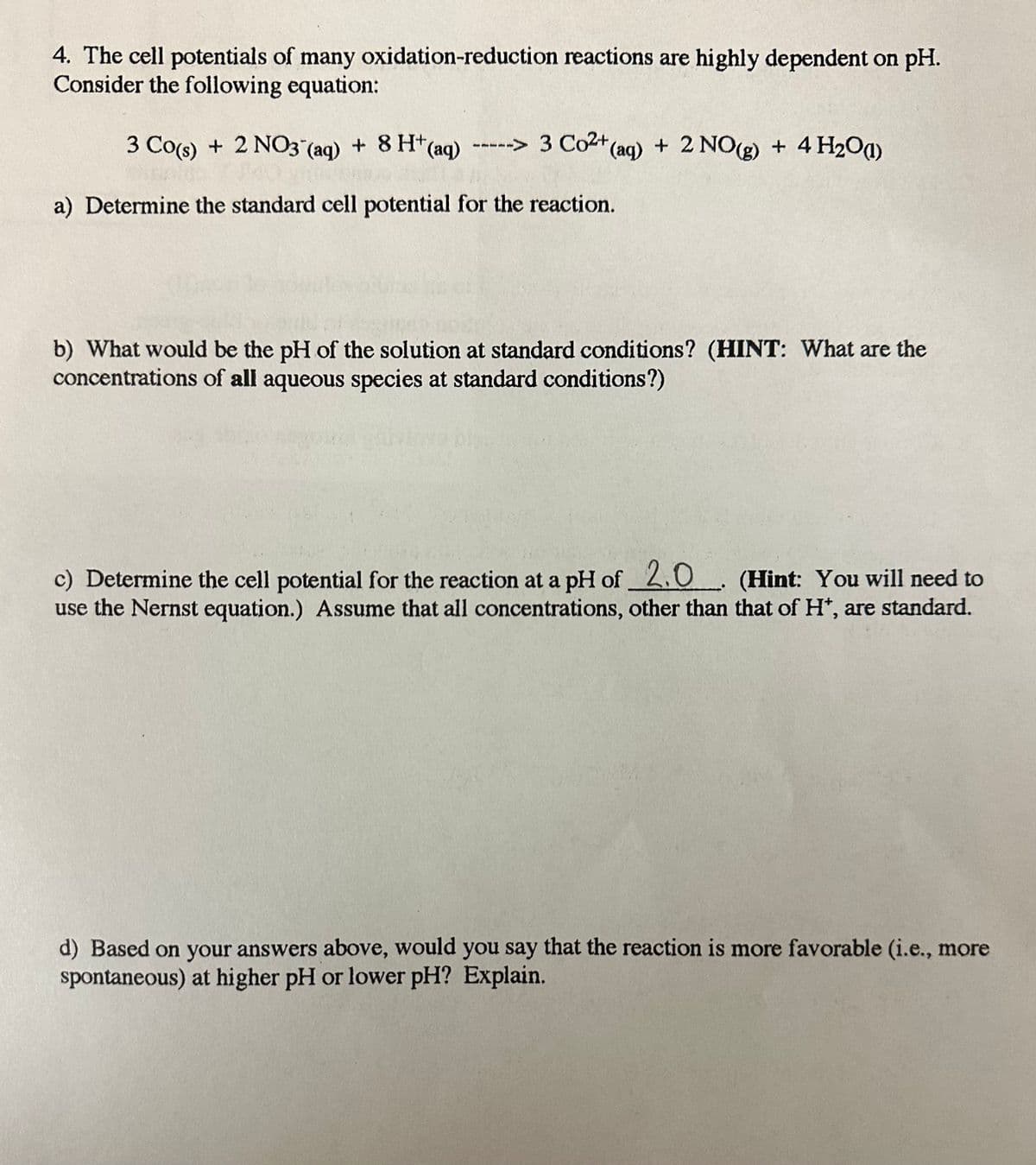4. The cell potentials of many oxidation-reduction reactions are highly dependent on pH. Consider the following equation: 3 Co(s) + 2NO3(aq) + 8 H+ (aq) -----> 3 Co2+ (aq) + 2NO(g) + 4H₂O(1) a) Determine the standard cell potential for the reaction. b) What would be the pH of the solution at standard conditions? (HINT: What are the concentrations of all aqueous species at standard conditions?) c) Determine the cell potential for the reaction at a pH of_2.0. (Hint: You will need to use the Nernst equation.) Assume that all concentrations, other than that of H*, are standard. d) Based on your answers above, would you say that the reaction is more favorable (i.e., more spontaneous) at higher pH or lower pH? Explain.
4. The cell potentials of many oxidation-reduction reactions are highly dependent on pH. Consider the following equation: 3 Co(s) + 2NO3(aq) + 8 H+ (aq) -----> 3 Co2+ (aq) + 2NO(g) + 4H₂O(1) a) Determine the standard cell potential for the reaction. b) What would be the pH of the solution at standard conditions? (HINT: What are the concentrations of all aqueous species at standard conditions?) c) Determine the cell potential for the reaction at a pH of_2.0. (Hint: You will need to use the Nernst equation.) Assume that all concentrations, other than that of H*, are standard. d) Based on your answers above, would you say that the reaction is more favorable (i.e., more spontaneous) at higher pH or lower pH? Explain.
Chemistry: Principles and Practice
3rd Edition
ISBN:9780534420123
Author:Daniel L. Reger, Scott R. Goode, David W. Ball, Edward Mercer
Publisher:Daniel L. Reger, Scott R. Goode, David W. Ball, Edward Mercer
Chapter18: Electrochemistry
Section: Chapter Questions
Problem 18.101QE: At 298 K, the solubility product constant for PbC2O4 is 8.5 1010, and the standard reduction...
Related questions
Question

Transcribed Image Text:4. The cell potentials of many oxidation-reduction reactions are highly dependent on pH.
Consider the following equation:
3 Co(s)
+ 2 NO3(aq) + 8 H+ (aq) -----> 3 Co²+ (aq) +
+(aq) + 2 NO(g) + 4H₂O)
a) Determine the standard cell potential for the reaction.
b) What would be the pH of the solution at standard conditions? (HINT: What are the
concentrations of all aqueous species at standard conditions?)
c) Determine the cell potential for the reaction at a pH of_2.0. (Hint: You will need to
use the Nernst equation.) Assume that all concentrations, other than that of H*, are standard.
d) Based on your answers above, would you say that the reaction is more favorable (i.e., more
spontaneous) at higher pH or lower pH? Explain.
Expert Solution
This question has been solved!
Explore an expertly crafted, step-by-step solution for a thorough understanding of key concepts.
This is a popular solution!
Trending now
This is a popular solution!
Step by step
Solved in 5 steps with 3 images

Follow-up Questions
Read through expert solutions to related follow-up questions below.
Follow-up Question
For part, b would the calculations be the same for NO3^- (aq) and CO^2+ (aq), meaning those species PH would also equal 0?
Solution
Follow-up Question
Why is the reaction more favorable at lower pH?
Solution
Knowledge Booster
Learn more about
Need a deep-dive on the concept behind this application? Look no further. Learn more about this topic, chemistry and related others by exploring similar questions and additional content below.Recommended textbooks for you

Chemistry: Principles and Practice
Chemistry
ISBN:
9780534420123
Author:
Daniel L. Reger, Scott R. Goode, David W. Ball, Edward Mercer
Publisher:
Cengage Learning

Principles of Modern Chemistry
Chemistry
ISBN:
9781305079113
Author:
David W. Oxtoby, H. Pat Gillis, Laurie J. Butler
Publisher:
Cengage Learning


Chemistry: Principles and Practice
Chemistry
ISBN:
9780534420123
Author:
Daniel L. Reger, Scott R. Goode, David W. Ball, Edward Mercer
Publisher:
Cengage Learning

Principles of Modern Chemistry
Chemistry
ISBN:
9781305079113
Author:
David W. Oxtoby, H. Pat Gillis, Laurie J. Butler
Publisher:
Cengage Learning


Chemistry
Chemistry
ISBN:
9781305957404
Author:
Steven S. Zumdahl, Susan A. Zumdahl, Donald J. DeCoste
Publisher:
Cengage Learning

Chemistry: The Molecular Science
Chemistry
ISBN:
9781285199047
Author:
John W. Moore, Conrad L. Stanitski
Publisher:
Cengage Learning

General Chemistry - Standalone book (MindTap Cour…
Chemistry
ISBN:
9781305580343
Author:
Steven D. Gammon, Ebbing, Darrell Ebbing, Steven D., Darrell; Gammon, Darrell Ebbing; Steven D. Gammon, Darrell D.; Gammon, Ebbing; Steven D. Gammon; Darrell
Publisher:
Cengage Learning